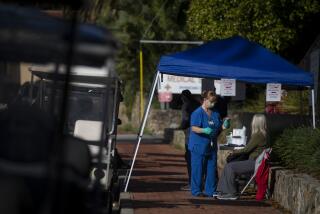San Diego’s big hospitals plan a push into medical tourism
Planning a visit to San Diego? Hit the beaches. Check. Spend a day at the zoo or a theme park. Check. Sample craft beer. Check. Book a stay at a local hospital for cutting-edge cardiac or cancer treatment?
For decades, San Diego has traded on its reputation for year-round sun, a captivating coastline and family-friendly attractions to woo tourists. But enticing visitors with the promise of lifesaving treatments by acclaimed physicians and hospitals has never been offered up as a selling point.
Until now.
A coalition of civic, tourism and business leaders, joined by San Diego’s four major hospitals, is launching a medical tourism initiative they hope will draw more well-heeled patients and their families to the region than any one hospital could attract on its own.
Dubbed DestinationCare San Diego, the effort has been seeded with an initial investment of $150,000, including $100,000 from businessman and longtime philanthropist Malin Burnham, who has been guiding the nascent effort for the last several years.
The hope is to tap into an industry valued at as much as $100 billion globally by trumpeting San Diego’s already highly regarded medical providers and life sciences research — and in the process attract visitors who otherwise might not consider traveling here.
The competition, though, is stiff, given the elevated profile of some of the nation’s most recognized names in healthcare — such as the Mayo Clinic in Rochester, Minn., Ohio’s Cleveland Clinic, Houston’s MD Anderson Cancer Center and New York’s Memorial Sloan Kettering Cancer Center.
What sets San Diego apart, say the effort’s most ardent supporters, is the willingness of the top medical institutions — Sharp Healthcare, Scripps Health, UC San Diego Health and Rady Children’s Hospital — to collaborate, no easy feat in a highly competitive arena.
DestinationCare, they also point out, marks the intersection of two of San Diego’s largest economic engines — tourism and healthcare.
“Medical tourism in a lot of people’s minds is ‘where can I get inexpensive care?’ This isn’t about getting a new set of teeth for half price,” said Tom Gehring, former chief executive of the San Diego County Medical Society and interim executive director of DestinationCare. “It’s about ‘why should I go to San Diego for the best possible treatment on the West Coast?’
“We as a region have an incredible synergy that the various other places can’t have. Given my choice of going to Rochester in the wintertime or San Diego, that’s a no-brainer.”
While DestinationCare is in its earliest stage, backers hope that the marketing effort will not only help enrich the hospitals, but also result in more spending at local hotels. Some of the initial funding for the program, in addition to Burnham’s $100,000 in seed money, has come from the city’s Tourism Marketing District, which relies on a 2% hotel room surcharge for generating its revenue stream.
What remains to be seen, though, is whether hospitals will be enthusiastic enough about the effort to contribute financially. For now, they are taking a wait-and-see approach until it can be proved there is a real return on investment.
Rady Children’s Hospital already boasts on its website that it is a “worldwide destination for the treatment of rare and complex medical conditions in children.” Likewise, UC San Diego Health brags that it is “known as a center for leading-edge medicine and outstanding clinical programs.”
Others tell moving tales of grateful patients, like baseball Hall of Famer Rod Carew who credits Scripps Health with bringing him “back from death’s door” by implanting a mechanical pump in his chest after a massive heart attack.
Although serving international patients is typically viewed as more lucrative, San Diego plans to focus its medical tourism efforts initially on patients within the U.S.
But it’s unclear how willing Americans are to travel within the U.S. for treatment and whether the economics are sustainable, says Josef Woodman, founder of Patients Beyond Borders, a resource for global medical travel.
“I don’t think anyone right now has the keys to the kingdom on domestic medical tourism,” he said. “San Diego has some quality hospitals and clinics, but I’ve seen a lot of folks belly up to the bar and fail. There is an untapped market but it’s a tough one because a lot of people are not willing to travel for their care and settle for the specialist that their [general practitioner] recommends in their own backyard.”
Burnham is convinced that by banding together the medical institutions will see far more impressive results than working on their own.
“We can bring hundreds of millions of dollars of new medical spending to San Diego that the hospitals aren’t getting on their own,” he said. “So, sure, they’ve got their own systems. But they’re in the back of the airplane, we’re in the front of the plane.”
Weisberg writes for the San Diego Union-Tribune. Times staff writer Paul Sisson contributed to this report.
lori.weisberg@sduniontribune.com






